| In 1845 Mr. George Briscoe, a local businessman,
fell from a chair at his home when cleaning a painting. Whilst
lying in bed with a broken leg he pondered the plight of those
less fortunate than he, who could not afford medical treatment.
Along with his friend Henry Rogers he resolved to do something
to help. Each donated £500 to the fund for the building of a new
hospital. |
|
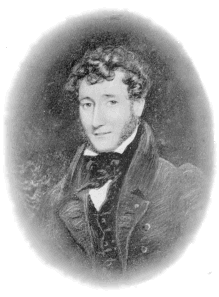
Mr. George Briscoe.
|
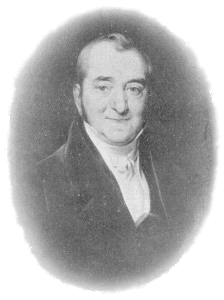
Mr. Henry Rogers.
|
|
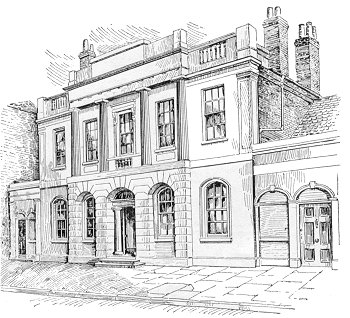
The original Dispensary in Queen Street. |
When the South Staffordshire General Hospital and
Dispensary opened its doors on 1st January 1849, it
replaced the small dispensary situated in Queen Street. The
foundation stone had been laid in 1846 on land purchased from the
Duke of Cleveland, in Cleveland Road. The total cost was £18,898
with £122 1s 6d spent on surgical equipment. The three storey
building was designed by Wolverhampton architect Edward Banks in the
Italian and Roman Doric style. The hospital had 80 beds, each paid
for by a subscription of 7 guineas. |
|
The first president of the hospital was The Second Duke of Cleveland,
until 1867 when the Earl of Lichfield was elected for two years. In 1869
the Earl of Dartmouth was invited to become president, establishing
almost 70 years of family association with the hospital until the Earl
of Harrowby became President in 1937. The staff consisted of a matron, 1
physician, 1 consulting surgeon, 3 surgeons, 1 house surgeon and a
secretary. The house surgeon, Mr. Edward Hayling Coleman, had, in 1847,
carried out the third ever operation using anaesthesia, in England. He
was later to become an Honorary Surgeon in October 1852, his grandson,
of the same name, became Honorary Physician at the hospital and his
great grandson a medical registrar there. 1852 was also the year Dr.
William Millington was appointed Honorary Physician. He was to be
associated with the hospital for 59 years, both as Honorary and Honorary
Consulting Physician. During his office he was instrumental along with
Dr. C. R. Smith and Mr. Richard Holt Briscoe, son of George Briscoe, in
founding the Wolverhampton and Midland Counties Eye Infirmary. For many
years his portrait hung on the walls of the Royal Hospital. |
| During the first year of operation, 408 in-patients
and 2,853 out-patients were treated. A ticket of recommendation was
required before a patient would be treated or receive medicines.
These were obtained by subscription of 5s 6d per ticket which the
subscriber could use himself or give to a deserving person. Many
influential people in the town subscribed and gave the tickets to
their employees or in the case of church officials, to members of
the congregation. |
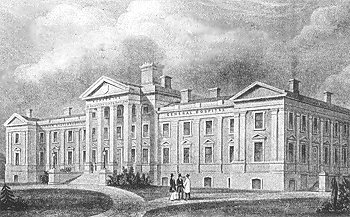
The South Staffordshire Hospital in
1849. |
| Patients too destitute to pay for medicines or
treatment and were unable to obtain one from a subscriber, could
still be admitted and treated provided the approval from the Board
of Management was obtained that the patient was a deserving cause.
The ticket system was a constant source of controversy between
doctors, subscribers and management, throughout the history of the
hospital. In November 1852 the words "Not to be used for begging
purposes" were added to the tickets, which remained in force until
1948. |
|

The hospital in the early 1920s. |
Until 1854 the hospital brewed its own beer and ale,
when quotation for ale at 1s 2d per gallon and beer at 8d per gallon
were accepted. The resident medical staff, nurses and servants were
given a daily allowance of ale for luncheon, dinner and supper. Ale
was also provided for consumption by the patients. |
| Over the years the consumption and costs of ale,
beer, sherry, port and brandy increased so much that numerous
requests to reduce the expenditure were repeatedly made by the Board
of Management.
Due to the exertions of several benevolent individuals, Rule 62
which excluded the treatment in the hospital of children under
six years of age, was rescinded and a children’s ward
established in 1862. The following year the Lodge was erected
and the hospital gates moved from the centre to nearer the
corners of the hospital grounds. |
| In 1867 the Mayor, Sir John Morris, was asked by the
Board of Management to convey to the proper authorities an
application to Her Majesty Queen Victoria to become a Patron of the
Hospital. Unfortunately the Queen felt unable to comply with the
request. |

A motor ambulance with patient, in the
1920s. |
| By 1869 overcrowding in the hospital had become a
serious problem. A meeting of the town representatives was
determined to extend and remodel the patient accommodation. This
resulted in the opening in 1872 of a new wing for in-patients and a
new out-patient block. The cost of these improvements was £13,597
exclusive of the costs to Mrs. R. Sheraton for furnishing Men's
Accident Ward; Mr. Joseph Cooper, Men's Surgical Ward, and the
Infections Ward by the late Mr. W. H. Rogers and furnished by his
daughters. In 1872 The Sanitary Committee of Wolverhampton
Corporation had suggested a permanent ward for infectious cases. In
response, a fever ward was established, opening it’s doors on 1st
January 1873. This was a separate building with no access from the
main hospital. This ward was later to become Deanesly Ward and
access to the main corridor was installed. The Town Council in 1882
fitted out the basement on condition they could send non-pauper
small pox cases. To prevent spread of infection the doors of the
fever ward were kept locked or secured by chains. 1873 also saw
official recognition of the hospital by the Royal College of
Surgeons, who gave it their approval as a teaching hospital. |
|
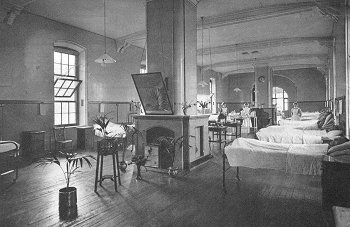
A men's surgical ward in the 1920s. |
Through the munificence of the late Mr. Edward Pugh,
a former member of the Board who donated £1000, the Bell Medical
Library was opened in 1877. From a bequest of the late Dr. Peter
Bell, a further £1000 was donated to the establishment of a medical
library, the interest on which was to be used for the purchase
medical books for the use of the medical staff of the hospital. It
was later opened to all medical men of the district in 1897 by Mr.
Vincent Jackson. |
| A separate building, it was later demolished to
make room for the new Out-Patients department, and many of the old
books were sold. In response to the discovery that one patient had
been in hospital for 130 weeks an eight week book was introduced in
1896, and no patient was to remain in the hospital without the
Board’s consent for longer than this time. |
| After almost fifty years of use the operating
theatre was renovated at a cost of £287 to bring it in line with
current acceptability for the antiseptic treatment of wounds. Mr.
Vincent Jackson carried out the supervision of this work, and it was
due to his endeavours that the refurbished theatre was reopened on
23rd June 1896 by Sir Christopher Heath, late President
of the Royal College of Surgeons, England. Mr. Jackson had been
mayor in the Queen’s jubilee year of 1887, the first member of the
medical profession to attain that honour. He worked tirelessly
throughout his career to improve the facilities of the hospital. By
this time the total cost of renovation and remodelling amounted to
just over £40,000, including the original cost of building the
hospital. |

Young nurses in the 1920s. |
| As the hospital moved into the 20th
century many of the modern facilities were introduced. Electricity
replaced gas lighting, and in 1900, the operating theatre was lit by
electricity. Over fifty years of use had required remodelling of the
kitchens and larders. A lift was installed in 1907. The early part
of the century also saw the X-ray and electrotherapeutical
department expand under the leadership of Dr. Codd. |
|
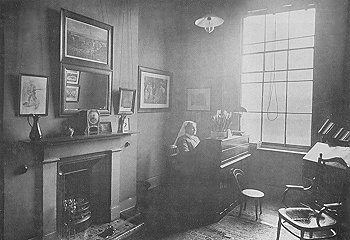
Matron's Office, in the 1920s. |
With the expansion of the hospital the need for a
nurses home became imperative. In 1883 two nearby houses had been
purchased by Mr. J. E. Briscoe for the use of the nursing staff. Land
was purchased in Portland and Sutherland Place and the foundation
stone for a new nurses home was laid by the Chairman, A. C. Twentyman
on 1st October 1907. The home, costing £8,000, was
formally opened by Lady Dartmouth on 12th June 1908. |
| After the ceremony a large crowd was admitted to
the home for a short time. When the public viewing was over it was
discovered that 53 tablets of soap had disappeared from the 53
bedrooms, presumably as souvenirs! |
| The death in 1910 of the king, Edward VII, prompted
the mayor Dr. John Grout to suggest a new wing to the hospital as a
memorial and a fund was begun to raise the necessary finance. The
fund raised £5,566 12s 1d of the £7,316 0s 3d needed to build and
equip the wing. The memorial, in the form of a two storey wing was
opened on 13th
November 1912. Queen Alexandra graciously gave her permission to
call the two wards Edward and Alexandra Wards. |
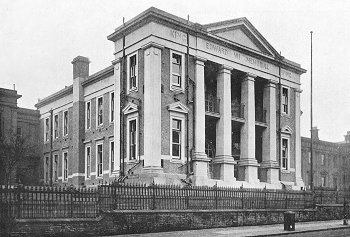
The King Edward VII Memorial Wing in 1923. |
| The opening ceremony was performed by the Earl of
Dartmouth, as Provincial Grand Master. Due to considerable public
opposition to the Masonic ceremony no word of the event appeared in
the annual report.
Later that year the death of Sister Annie MacLaren led to
another ward being named in memorium. Sister MacLaren had for
many years been in charge of Ward 1, Men’s Accident. It was felt
fitting to name the ward in her memory and place her portrait
over the entrance of the ward to which she gave so many years of
her nursing career. This year also saw the introduction of a
motor ambulance, presented to the hospital by the Wolverhampton
Police Force after a public appeal to raise £500. |
|

An aerial view of the hospital. |
Developments in medicine, and the scientific
discoveries in the pathology of disease led to the decision that the
hospital should have a pathology department. Between 1889 and 1909 a
small room in the fever block had served as a laboratory for Dr.
Charles MacMunn. Although Honorary Physician he was also elected
Honorary Pathological Officer. He carried out scientific work in
spectroscopy, writing several books and papers on the subject. |
| His greatest achievement was the discovery of
Cytochrome (which he called Myohaematin). Unfortunately his work was
not accepted by the scientific community, until many years after his
death. Sadly no memorial exists to this pioneer of medical
spectroscopy. A purpose built and equipped laboratory was opened by
Sir Clifford Allbutt in January 1914 and William Boyd appointed
pathologist at £200 per ann. Eight months later he was appointed
Professor of Pathology at the University of Winnipeg. |
|

The House Governor's Office in the 1920s. |
The outbreak of hostilities in 1914 saw many of the
medical and nursing staff called upon for military duties. Drs.
Dent, Stidston, Boyd, Armitage and Strange all served in France.
Stidston and Armitage were awarded the DSO, the latter being the
only member of the hospital staff to lose his life in the war. The
Matron, Miss Hannath, received the Red Cross Award 1st
Class, several of the sisters received the 2nd Class
award and Sister Spence was awarded the Military Medal. The
departing of staff for the front lead to a revolution in the
hospital. |
|
For the first time in its almost seventy year history
lady doctors were employed.
Between the wars was a period of great change. New
departments were created or refurbished and many new members of staff
were appointed. This was due in part to the foresight of Edward
Deanesly. He advocated that to attract the best medical staff they
should be paid as full time hospital clinicians rather than having a
private practice and a small honorarium for their work at the hospital.
In this way clinicians such as J. H. Sheldon, S. C. Dyke, Maslen-Jones,
R. Milnes-Walker and several others were attracted to Wolverhampton. A
diabetic clinic, VD department, ENT department, and orthopaedics were
established. A new out-patient and casualty department were built,
radiotherapy was begun after a supply of Radium (240 milligrams) was
purchased for £4,000 in 1929. The hospital was later recognised as the
Regional Centre for Radium Therapy in 1936.
|
| One of the most important dates in the history of
the hospital was the visit on 13th June 1923 by HRH The
Prince of Wales who presented the hospital Board and Medical Staff
with a Royal Charter of Incorporation, establishing the hospital as
a legally constituted body. That same year saw the General Nursing
Council approve the hospital for nurse training. |

The hospital in the 1990's. |
| Five years later on 28th
December 1928, HM King George V decreed that the Wolverhampton and
Staffordshire General Hospital should henceforth be known as The
Royal Hospital, Wolverhampton. The hospital applied for and was
granted a coat of arms in July 1930. |
‘Argent a cross gules on a chief sable three wolves
heads erased or’
|

Sir Keith Joseph at the opening ceremony in
1972. |
Construction of a new block of wards and operating
theatres was begun in 1937. The wing was eventually built with four
storeys after financial constraints had originally dictated a three
storey building. The wing also incorporated a swimming pool. The
1960’s saw many of the wards renovated and an ITU ward opened by Sir
Keith Joseph in 1972. Much of the reconstruction had been completed
by this date and the last twenty years saw little in the way of
development. Many of the specialities moved away to the New Cross
Hospital and the wards closed. With the coming of the NHS in 1948
the hospital celebrated its centenary, as the one hundred and forty
eighth anniversary approached the Royal Hospital closed in 1997. |
A successful open day was held prior to closure and
many former members of staff and patients were able to take one last
memorable stroll around the corridors and wards. There were plenty of
moist eyes that day! Broken windows, crumbling stonework and weeds
growing through the roofing tiles are a sad monument to the institution
where many eminent and respected members of the medical and nursing
professions climbed the steps to enter via its columned portals. Where
Matron would march along the corridors, and the rattle of her keys
announced her presence on the ward.
The final use of the old Royal Hospital is still to be
decided. Much of it has been rebuilt, and it is up for sale. Hopefully
its future will soon become clear.
|

|
|

|
|
A Photographic Tour of
the Hospital |
|
Return to the Health
Section |
|

















